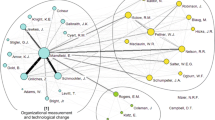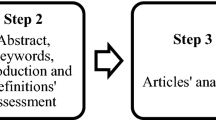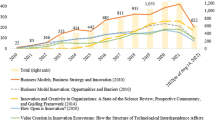Abstract
This article aims to provide an analysis of the information on scientific research publications related to Innovation Management available on the Web of Science. For this, a bibliometric study of the publications of the Web of Science Core Collection database on Innovation Management is carried out. The study considers all the documents published during the period from 1982 to 2018. In the search, the type of document selected is by article, review, and note for researchers interested in the subject. The study graphically maps the bibliographic material by using the VOS viewer software, to provide a more in-depth analysis of data obtained from the search. The present work shows the analysis of data of the publications on Innovation management. Identify the leading publications, the most productive authors, the most productive countries, the most productive institutions, and analyze their evolution over time. The above are some of the data obtained in the analysis. Therefore, the results of the bibliometric study show that Innovation Management remains a topic of interest in research, presents significant development of the journal over time, and provides a synthesis of research for new researchers.
Access this chapter
Tax calculation will be finalised at checkout
Purchases are for personal use only
Similar content being viewed by others
References
Bilton C, Cummings S (2010) Creative strategy: reconnecting business and innovation. John Wiley & Sons, Chichester
Damanpour F (1987) The adoption of technological, administrative, and ancillary innovations: impact of organizational factors. J Manage 13(4):675–688
Kim D-Y, Kumar V, Kumar U (2012) Relationship between quality management practices and innovation. J Oper Manage 30(4):295–315
Weerawardena J (2003) The role of marketing capability in innovation based competitive strategy. J Strateg Mark 11(1):15–36
Tomala.F, Séméchal. O. (2004) Innovation management: a synthesis of academic and industrial points of view. Int J Project Manage 22(2):281–287
Lawson B, Samson D (2001) Developing innovation capability in organisations: a dynamic capabilities approach. Int J Innovation Manage 5(03):377–400
Santos J, Zawislak P, Franzoni G, y Vieira, H. (2015) Buscando un camino: un estudio bibliométrico sobre innovación y capacidades tecnológicas. Revista Internacional de Innovación - IJI 3(2):54–66. https://doi.org/10.5585/iji.v3i2.58
Yam RC, Guan JC, Pun KF, Tang EP (2004) An audit of technological innovation capabilities in Chinese firms: some empirical findings in Beijing, China. Res Policy 33(8):1123–1140
Damanpour F (1991) Organizational innovation: A meta-analysis of effects of determinants and moderators. Acad Manage J 34:555–590
Damanpour F, Evan WM (1984) Organizational innovation and performance: the problem of organizational lag. Adm Sci Q 29:392–409
Damanpour F, Szabat KA, Evan WM (1989) The relationship between types of innovation and organizational performance. J Manage Stud 26(6):587–601
Battisti G, Stoneman P (2010) How innovative are UK firms? Evidence from the fourth UK community innovation survey on synergies between technological and organizational innovations. Br J Manage 21:187–206
Damanpour F, Aravind D (2011) Managerial innovation: conceptions, processes, and antecedents. Manage Org Rev
Damanpour F (2014) Footnotes to research on management innovation. Organ Stud 35:1265–1285
Hervas-Oliver JL, Sempere-Ripoll F, Boronat-Moll C, Rojas R (2015) Technological innovation without R&D: unfolding the extra gains of management innovations on technological performance. Technol Anal Strat Manage 27(1):19–38
Hervas-Oliver J, Ripoll-Sempere F, y Moll, C. (2016) ¿Beneficia la innovación de la gestión en las PYME? Evidencia empírica para las PYMES españolas. Small Bus Econ 47(2):507–533
Hervas-Oliver F-R, Boronat-Moll C, Rojas-Alvarado R (2018) On the joint effect of technological and management innovations on performance: increasing or diminishing returns? Technol Anal Strat Manage 30(5):569–581
Volberda HW, Frans VD, Bosch AJ, Mihalache OR (2014) Advancing management innovation: synthesizing processes. Levels Anal Change Agents Org Stud 2014(35):1245
Volberda HW, Bosch D, Van F, A. J., & Heij, Cornelis V. (2013) Management innovation: management as fertile ground for innovation. Eur Manage Rev 10(1):1–15
Wang W, Laengle S, Merigó JM, Yu D, Herrera-Viedma E, Cobo MJ, Bouchon-Meunier B (2018) A bibliometric analysis of the first twenty-five years of the international journal of uncertainty, fuzziness and knowledge based systems. Int J Uncertain Fuzz Knowl Based Syst 26:169–193
Merigo JM, Yang JB (2017) A bibliometric analysis of operations research and management science. Omega-Int J Manage Sci 73:37–48
de Solla Price DJ (1965) Networks of science papers. Science 149(3683):510–155
Small H (1973) Co-citation in the relationship between two documents. J Am Soc Inf Sci 24:256–269
Small H (2010) Emerging research fronts in science and technology: patterns of new knowledge development. Scientometrics 83:15–38
Kessler MM (1963) Bibliographic coupling between scientific papers. Am Doc 14(1):10–25
White HD, Griffith B (1981) Author co-citation: a literature Measure of Intellectual structure. J Am Soc Inf Sci 32(3):163–172
Glänzel W (2001) National characteristics in international scientific co-authorship relations. Scientometrics 51:69–115
Van Eck NJ, Waltman L (2010) Software survey: VOSviewer, a computer program for bibliometric mapping. Scientometrics 84(2):523–538. https://doi.org/10.1007/s11192-009-0146-3
Blanco-Mesa F, Merigó JM, Gil-Lafuente AM (2017) Fuzzy decision making: a bibliometric-based review. J Intell Fuzzy Syst 32(3):2033–2050. https://doi.org/10.3233/JIFS-161640
Ortiz-de-Urbina-Criado M, Najera-Sanchez JJ, Mora-Valentin EM (2018) A research agenda on open innovation and entrepreneurship: a co-word analysis. Admin Sci 8(3):34
Caputo A, Marzi G, Pellegrini MM, Rialti R (2018) Conflict management in family businesses: a bibliometric analysis and systematic literature review. Int J Confl Manage 29(4):519–542
Blanco-Mesa F, León-Castro E, Merigó JM (2019) A bibliometric analysis of aggregation operators. Appl Soft Comput 105488. https://doi.org/10.1016/j.asoc.2019.105488
Rey-Martí A, Ribeiro-Soriano D, Palacios-Marqués D (2016) A bibliometric analysis of social entrepreneurship. J Bus Res 69(5):1651–1655. https://doi.org/10.1016/j.jbusres.2015.10.033
Soosaraei M, Khasseh AA, Fakhar M, Hezarjaribi HZ (2018) A decade bibliometric analysis of global research on leishmaniasis in Web of Science database. Ann Med Surg 26:30–37. https://doi.org/10.1016/j.amsu.2017.12.014
Van Nunen K, Li J, Reniers G, Ponnet K (2018) Bibliometric analysis of safety culture research. Saf Sci 108:248–258. https://doi.org/10.1016/j.ssci.2017.08.011
Calantone RJ, Cavusgil ST, Zhao Y (2002) Learning orientation, firm innovation capability, and firm performance. Ind Mark Manage 31(6):515–524
Teece DJ (2010) Business models, business strategy and innovation. Long Range Plan 43(2–3):172–194
Chen CC, Greene PG, Crick A (1998) Does entrepreneurial self-efficacy distinguish entrepreneurs from managers? J Bus Ventur 13(4):295–316
Huizingh EK (2011) Open innovation: state of the art and future perspectives. Technovation 31(1):2–9
Anderson N, Potočnik K, Zhou J (2014) Innovation and creativity in organizations: a state-of-the-science review, prospective commentary, and guiding framework. J Manage 40(5):1297–1333
Sivadas E, Dwyer FR (2000) An examination of organizational factors influencing new product success in internal and alliance-based processes. J Mark 64(1):31–49
Hobday M (1998) Product complexity, innovation and industrial organisation. Res Policy 26(6):689–710
Adams R, Bessant J, Phelps R (2006) Innovation management measurement: a review. Int J Manag Rev 8(1):21–47
Lin HF (2007) Knowledge sharing and firm innovation capability: an empirical study. Int J Manpow 28(3/4):315–332
Romijn H, Albaladejo M (2002) Determinants of innovation capability in small electronics and software firms in southeast England. Res Policy 31(7):1053–1067
Lilien GL, Morrison PD, Searls K, Sonnack M, Hippel EV (2002) Performance assessment of the lead user idea-generation process for new product development. Manage Sci 48(8):1042–1059
West J, Bogers M (2014) Leveraging external sources of innovation: a review of research on open innovation. J Prod Innov Manage 31(4):814–831
Hargrave TJ, Van de Ven AH (2006) A collective action model of institutional innovation. Acad Manage Rev 31(4):864–888
Tidd J (2001) Innovation management in context: environment, organization and performance. Int J Manage Rev 3(3):169–183
Chiesa V, Coughlan P, Voss CA (1996) Development of a technical innovation audit. J Prod Innov Manage Int Publ Prod Dev Manage Assoc 13(2):105–136
Sawhney M, Prandelli E (2000) Communities of creation: managing distributed innovation in turbulent markets. Calif Manage Rev 42(4):24–54
Faraj S, Jarvenpaa SL, Majchrzak A (2011) Knowledge collaboration in online communities. Organ Sci 22(5):1224–1239
Keupp MM, Gassmann O (2009) The past and the future of international entrepreneurship: a review and suggestions for developing the field. J Manage 35(3):600–633
Verganti R (2008) Design, meanings, and radical innovation: a metamodel and a research agenda. J Prod Innov Manage 25(5):436–456
Klerkx L, Aarts N, Leeuwis C (2010) Adaptive management in agricultural innovation systems: the interactions between innovation networks and their environment. Agric Syst 103(6):390–400
Guan J, Ma N (2003) Innovative capability and export performance of Chinese firms. Technovation 23(9):737–747
Den Hertog P, Van der Aa W, De Jong MW (2010) Capabilities for managing service innovation: towards a conceptual framework. J Serv Manage 21(4):490–514
Terziovski M (2010) Innovation practice and its performance implications in small and medium enterprises (SMEs) in the manufacturing sector: a resource-based view. Strateg Manage J 31(8):892–902
Yoo Y, Boland RJ Jr, Lyytinen K, Majchrzak A (2012) Organizing for innovation in the digitized world. Organ Sci 23(5):1398–1408
Tatikonda MV, Rosenthal SR (2000) Successful execution of product development projects: balancing firmness and flexibility in the innovation process. J Oper Manage 18(4):401–425
Weber KM, Rohracher H (2012) Legitimizing research, technology and innovation policies for transformative change: combining insights from innovation systems and multi-level perspective in a comprehensive ‘failures’ framework. Res Policy 41(6):1037–1047
Peng DX, Schroeder RG, Shah R (2008) Linking routines to operations capabilities: a new perspective. J Oper Manag 26(6):730–748
Siguaw JA, Simpson PM, Enz CA (2006) Conceptualizing innovation orientation: a framework for study and integration of innovation research. J Prod Innov Manage 23(6):556–574
Toivonen M, Tuominen T (2009) Emergence of innovations in services. Serv Ind J 29(7):887–902
Francis D, Bessant J (2005) Targeting innovation and implications for capability development. Technovation 25(3):171–183
Liao SH, Fei WC, Chen CC (2007) Knowledge sharing, absorptive capacity, and innovation capability: an empirical study of Taiwan’s knowledge-intensive industries. J Inf Sci 33(3):340–359
Fuchs C, Schreier M (2011) Customer empowerment in new product development. J Prod Innov Manage 28(1):17–32
Prajogo DI, Ahmed PK (2006) Relationships between innovation stimulus, innovation capacity, and innovation performance. R&D Manage 36(5):499–515
Wolff JA, Pett TL (2006) Small-firm performance: modeling the role of product and process improvements. J Small Bus Manage 44(2):268–284
Flatten TC, Engelen A, Zahra SA, Brettel M (2011) A measure of absorptive capacity: scale development and validation. Eur Manage J 29(2):98–116
Zaglia ME (2013) Brand communities embedded in social networks. J Bus Res 66(2):216–223
Schiederig T, Tietze F, Herstatt C (2012) Green innovation in technology and innovation management–an exploratory literature review. R&D Manage 42(2):180–192
Bledow R, Frese M, Anderson N, Erez M, Farr J (2009) A dialectic perspective on innovation: conflicting demands, multiple pathways, and ambidexterity. Ind Organ Psychol 2(3):305–337
Altenburg T, Schmitz H, Stamm A (2008) Breakthrough? China’s and India’s transition from production to innovation. World Dev 36(2):325–344
Oke A (2007) Innovation types and innovation management practices in service companies. Int J Oper Prod Manage 27(6):564–587
Chiaroni D, Chiesa V, Frattini F (2011) The open innovation journey: how firms dynamically implement the emerging innovation management paradigm. Technovation 31(1):34–43
Brem A, Voigt KI (2009) Integration of market pull and technology push in the corporate front end and innovation management—insights from the German software industry. Technovation 29(5):351–367
Baker WE, Sinkula JM (2005) Market orientation and the new product paradox. J Prod Innov Manage 22(6):483–502
Ebner W, Leimeister JM, Krcmar H (2009) Community engineering for innovations: the ideas competition as a method to nurture a virtual community for innovations. R&D Manage 39(4):342–356
Cormican K, O’Sullivan D (2004) Auditing best practice for effective product innovation management. Technovation 24(10):819–829
Author information
Authors and Affiliations
Corresponding author
Editor information
Editors and Affiliations
Rights and permissions
Copyright information
© 2022 The Author(s), under exclusive license to Springer Nature Switzerland AG
About this chapter
Cite this chapter
Ballardo-Cárdenas, D., León-Castro, E., Blanco-Mesa, F., Martínez-Huerta, R. (2022). A Bibliometric Analysis on Innovation Management Research. In: León-Castro, E., Blanco-Mesa, F., Alfaro-García, V., Gil-Lafuente, A.M., Merigó, J.M., Kacprzyk, J. (eds) Soft Computing and Fuzzy Methodologies in Innovation Management and Sustainability. Lecture Notes in Networks and Systems, vol 337. Springer, Cham. https://doi.org/10.1007/978-3-030-96150-3_17
Download citation
DOI: https://doi.org/10.1007/978-3-030-96150-3_17
Published:
Publisher Name: Springer, Cham
Print ISBN: 978-3-030-96149-7
Online ISBN: 978-3-030-96150-3
eBook Packages: Intelligent Technologies and RoboticsIntelligent Technologies and Robotics (R0)




